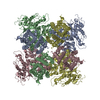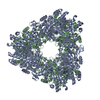+ Open data
Open data
- Basic information
Basic information
| Entry | Database: EMDB / ID: EMD-8414 | |||||||||
|---|---|---|---|---|---|---|---|---|---|---|
| Title | Ca2+ bound aplysia Slo1 | |||||||||
 Map data Map data | Aplysia Slo1 in 1 mM EDTA | |||||||||
 Sample Sample |
| |||||||||
 Keywords Keywords | ion channel / K+ channel / Ca2+ bound / high conductance / MEMBRANE PROTEIN | |||||||||
| Function / homology |  Function and homology information Function and homology informationlarge conductance calcium-activated potassium channel activity / monoatomic ion channel complex / postsynaptic membrane Similarity search - Function | |||||||||
| Biological species |  | |||||||||
| Method | single particle reconstruction / cryo EM / Resolution: 3.8 Å | |||||||||
 Authors Authors | MacKinnon R / Tao X | |||||||||
| Funding support |  United States, 2 items United States, 2 items
| |||||||||
 Citation Citation |  Journal: Nature / Year: 2017 Journal: Nature / Year: 2017Title: Structural basis for gating the high-conductance Ca-activated K channel. Authors: Richard K Hite / Xiao Tao / Roderick MacKinnon /  Abstract: The precise control of an ion channel gate by environmental stimuli is crucial for the fulfilment of its biological role. The gate in Slo1 K channels is regulated by two separate stimuli, ...The precise control of an ion channel gate by environmental stimuli is crucial for the fulfilment of its biological role. The gate in Slo1 K channels is regulated by two separate stimuli, intracellular Ca concentration and membrane voltage. Slo1 is thus central to understanding the relationship between intracellular Ca and membrane excitability. Here we present the Slo1 structure from Aplysia californica in the absence of Ca and compare it with the Ca-bound channel. We show that Ca binding at two unique binding sites per subunit stabilizes an expanded conformation of the Ca sensor gating ring. These conformational changes are propagated from the gating ring to the pore through covalent linkers and through protein interfaces formed between the gating ring and the voltage sensors. The gating ring and the voltage sensors are directly connected through these interfaces, which allow membrane voltage to regulate gating of the pore by influencing the Ca sensors. | |||||||||
| History |
|
- Structure visualization
Structure visualization
| Movie |
 Movie viewer Movie viewer |
|---|---|
| Structure viewer | EM map:  SurfView SurfView Molmil Molmil Jmol/JSmol Jmol/JSmol |
- Downloads & links
Downloads & links
-EMDB archive
| Map data |  emd_8414.map.gz emd_8414.map.gz | 5.1 MB |  EMDB map data format EMDB map data format | |
|---|---|---|---|---|
| Header (meta data) |  emd-8414-v30.xml emd-8414-v30.xml emd-8414.xml emd-8414.xml | 16.8 KB 16.8 KB | Display Display |  EMDB header EMDB header |
| Images |  emd_8414.png emd_8414.png | 172.1 KB | ||
| Filedesc metadata |  emd-8414.cif.gz emd-8414.cif.gz | 6.7 KB | ||
| Archive directory |  http://ftp.pdbj.org/pub/emdb/structures/EMD-8414 http://ftp.pdbj.org/pub/emdb/structures/EMD-8414 ftp://ftp.pdbj.org/pub/emdb/structures/EMD-8414 ftp://ftp.pdbj.org/pub/emdb/structures/EMD-8414 | HTTPS FTP |
-Validation report
| Summary document |  emd_8414_validation.pdf.gz emd_8414_validation.pdf.gz | 369.9 KB | Display |  EMDB validaton report EMDB validaton report |
|---|---|---|---|---|
| Full document |  emd_8414_full_validation.pdf.gz emd_8414_full_validation.pdf.gz | 369.4 KB | Display | |
| Data in XML |  emd_8414_validation.xml.gz emd_8414_validation.xml.gz | 6.3 KB | Display | |
| Data in CIF |  emd_8414_validation.cif.gz emd_8414_validation.cif.gz | 7.1 KB | Display | |
| Arichive directory |  https://ftp.pdbj.org/pub/emdb/validation_reports/EMD-8414 https://ftp.pdbj.org/pub/emdb/validation_reports/EMD-8414 ftp://ftp.pdbj.org/pub/emdb/validation_reports/EMD-8414 ftp://ftp.pdbj.org/pub/emdb/validation_reports/EMD-8414 | HTTPS FTP |
-Related structure data
| Related structure data |  5tjiMC M: atomic model generated by this map C: citing same article ( |
|---|---|
| Similar structure data |
- Links
Links
| EMDB pages |  EMDB (EBI/PDBe) / EMDB (EBI/PDBe) /  EMDataResource EMDataResource |
|---|---|
| Related items in Molecule of the Month |
- Map
Map
| File |  Download / File: emd_8414.map.gz / Format: CCP4 / Size: 64 MB / Type: IMAGE STORED AS FLOATING POINT NUMBER (4 BYTES) Download / File: emd_8414.map.gz / Format: CCP4 / Size: 64 MB / Type: IMAGE STORED AS FLOATING POINT NUMBER (4 BYTES) | ||||||||||||||||||||||||||||||||||||||||||||||||||||||||||||||||||||
|---|---|---|---|---|---|---|---|---|---|---|---|---|---|---|---|---|---|---|---|---|---|---|---|---|---|---|---|---|---|---|---|---|---|---|---|---|---|---|---|---|---|---|---|---|---|---|---|---|---|---|---|---|---|---|---|---|---|---|---|---|---|---|---|---|---|---|---|---|---|
| Annotation | Aplysia Slo1 in 1 mM EDTA | ||||||||||||||||||||||||||||||||||||||||||||||||||||||||||||||||||||
| Voxel size | X=Y=Z: 1.35 Å | ||||||||||||||||||||||||||||||||||||||||||||||||||||||||||||||||||||
| Density |
| ||||||||||||||||||||||||||||||||||||||||||||||||||||||||||||||||||||
| Symmetry | Space group: 1 | ||||||||||||||||||||||||||||||||||||||||||||||||||||||||||||||||||||
| Details | EMDB XML:
CCP4 map header:
| ||||||||||||||||||||||||||||||||||||||||||||||||||||||||||||||||||||
-Supplemental data
- Sample components
Sample components
-Entire : Ca2+ bound aplysia Slo1
| Entire | Name: Ca2+ bound aplysia Slo1 |
|---|---|
| Components |
|
-Supramolecule #1: Ca2+ bound aplysia Slo1
| Supramolecule | Name: Ca2+ bound aplysia Slo1 / type: organelle_or_cellular_component / ID: 1 / Parent: 0 / Macromolecule list: #1 |
|---|---|
| Source (natural) | Organism:  |
| Molecular weight | Theoretical: 400 KDa |
-Macromolecule #1: High conductance calcium-activated potassium channel
| Macromolecule | Name: High conductance calcium-activated potassium channel / type: protein_or_peptide / ID: 1 / Number of copies: 1 / Enantiomer: LEVO |
|---|---|
| Source (natural) | Organism:  |
| Molecular weight | Theoretical: 120.308 KDa |
| Recombinant expression | Organism:  Trichoplusia ni (cabbage looper) Trichoplusia ni (cabbage looper) |
| Sequence | String: MASSSSTSCE PGDRQWYSFL ASSLVTFGSG LVVIIIYRIV LWLCCRKKKC IQVSNPVPTA RTTSLDQKSF MKNSDPEIGW MTEAKDWAG ELISGQTTTG RILVGLVFLL SIASLIIYFI DASTNTSVET CLPWSSSTTQ QVDLAFNVFF MIYFFIRFVA A NDKLWFWV ...String: MASSSSTSCE PGDRQWYSFL ASSLVTFGSG LVVIIIYRIV LWLCCRKKKC IQVSNPVPTA RTTSLDQKSF MKNSDPEIGW MTEAKDWAG ELISGQTTTG RILVGLVFLL SIASLIIYFI DASTNTSVET CLPWSSSTTQ QVDLAFNVFF MIYFFIRFVA A NDKLWFWV ELFSFVDYFT IPPSFVAIYL DRNWLGLRFL RALRLMSIPD ILTYLNVLKT STLIRLVQLV VSFVSLWLTA AG FLHLLEN SGDPFFDFGN AQHLTYWECL YFLMVTMSTV GFGDIFATTV LGRTFVVIFI MIFIGLFASF IPEIAEILGK RQK YGGSYK KERGKRHVVV CGYITFDSVS NFLKDFLHKD REDVDVEIVF LHKGLPGLEL EGLLKRHFTQ VEYFWGSVMD ANDL ERVKI QEADACLVLA NKYCQDPDQE DAANIMRVIS IKNYHSDIKV IVQLLQYHNK AYLLNIPSWD WKRGDDAVCV AELKL GFIA QSCLAPGFST LMANLFTMRS YKPTPEMSQW QTDYMRGTGM EMYTEYLSSA FNALTFPEAA ELCFSKLKLL LLAIEV RQE DTRESTLAIN PGPKVKIENA TQGFFIAESA EEVKRAFYYC KNCHANVSDV RQIKKCKCRP LAMFKKGAAA VLALQRT PG LAVEPDGEAN DKDKSRGTST SKAVTSFPEK RKPQSRRKPS TTLKSKSPSE DSVPPPPPPV DEPRKFDSTG MFHWCPDR P LNDCLQDRSQ ASASGLRNHV VVCLFADAAS PLIGLRNLVM PLRASNFHYH ELKPTIIVGN LDYLHREWKT LQNFPKLSI LPGSPLNRAN LRAVNINLCD MCVIVSAKDR NMEDPNLVDK EAILCSLNIK AMTFDDTMGL IQSSNFVPGG FSPLHENKRS QAGANVPLI TELANDSNVQ FLDQDDDDDP DTELYMTQPF ACGTAFAVSV LDSLMSTSYF NDNALTLIRT LITGGATPEL E QILAEGAG MRGGYCSPAV LANRDRCRVA QISLFDGPLA QFGQGGHYGE LFVYALRHFG ILCIGLYRFR DTNESVRSPS SK RYVITNP PEDFPLLPTD QVYVLTYKQI TNH UniProtKB: BK channel |
-Macromolecule #2: (1R)-2-{[(S)-{[(2S)-2,3-dihydroxypropyl]oxy}(hydroxy)phosphoryl]o...
| Macromolecule | Name: (1R)-2-{[(S)-{[(2S)-2,3-dihydroxypropyl]oxy}(hydroxy)phosphoryl]oxy}-1-[(hexadecanoyloxy)methyl]ethyl (9Z)-octadec-9-enoate type: ligand / ID: 2 / Number of copies: 1 / Formula: PGW |
|---|---|
| Molecular weight | Theoretical: 749.007 Da |
-Experimental details
-Structure determination
| Method | cryo EM |
|---|---|
 Processing Processing | single particle reconstruction |
| Aggregation state | particle |
- Sample preparation
Sample preparation
| Concentration | 7 mg/mL | ||||||||||||||||||||||||
|---|---|---|---|---|---|---|---|---|---|---|---|---|---|---|---|---|---|---|---|---|---|---|---|---|---|
| Buffer | pH: 8 Component:
| ||||||||||||||||||||||||
| Grid | Model: Quantifoil R1.2/1.3 / Material: COPPER / Mesh: 400 / Support film - Material: CARBON / Support film - topology: HOLEY / Pretreatment - Type: GLOW DISCHARGE / Pretreatment - Time: 10 sec. / Pretreatment - Atmosphere: AIR | ||||||||||||||||||||||||
| Vitrification | Cryogen name: ETHANE / Chamber humidity: 85 % / Chamber temperature: 293 K / Instrument: FEI VITROBOT MARK IV |
- Electron microscopy
Electron microscopy
| Microscope | FEI TITAN KRIOS |
|---|---|
| Specialist optics | Spherical aberration corrector: FEI Cs corrector on Titan Krios Energy filter - Name: GIF / Energy filter - Lower energy threshold: -15 eV / Energy filter - Upper energy threshold: 15 eV |
| Image recording | Film or detector model: GATAN K2 SUMMIT (4k x 4k) / Detector mode: SUPER-RESOLUTION / Digitization - Dimensions - Width: 7420 pixel / Digitization - Dimensions - Height: 7676 pixel / Digitization - Frames/image: 1-50 / Number grids imaged: 1 / Number real images: 4000 / Average exposure time: 0.3 sec. / Average electron dose: 1.4 e/Å2 |
| Electron beam | Acceleration voltage: 300 kV / Electron source:  FIELD EMISSION GUN FIELD EMISSION GUN |
| Electron optics | Illumination mode: FLOOD BEAM / Imaging mode: BRIGHT FIELD / Cs: 2.7 mm / Nominal defocus max: 2.5 µm / Nominal defocus min: 1.0 µm / Nominal magnification: 22500 |
| Sample stage | Specimen holder model: FEI TITAN KRIOS AUTOGRID HOLDER / Cooling holder cryogen: NITROGEN |
| Experimental equipment |  Model: Titan Krios / Image courtesy: FEI Company |
+ Image processing
Image processing
-Atomic model buiding 1
| Refinement | Space: RECIPROCAL / Protocol: AB INITIO MODEL / Overall B value: 160 |
|---|---|
| Output model |  PDB-5tji: |
 Movie
Movie Controller
Controller














